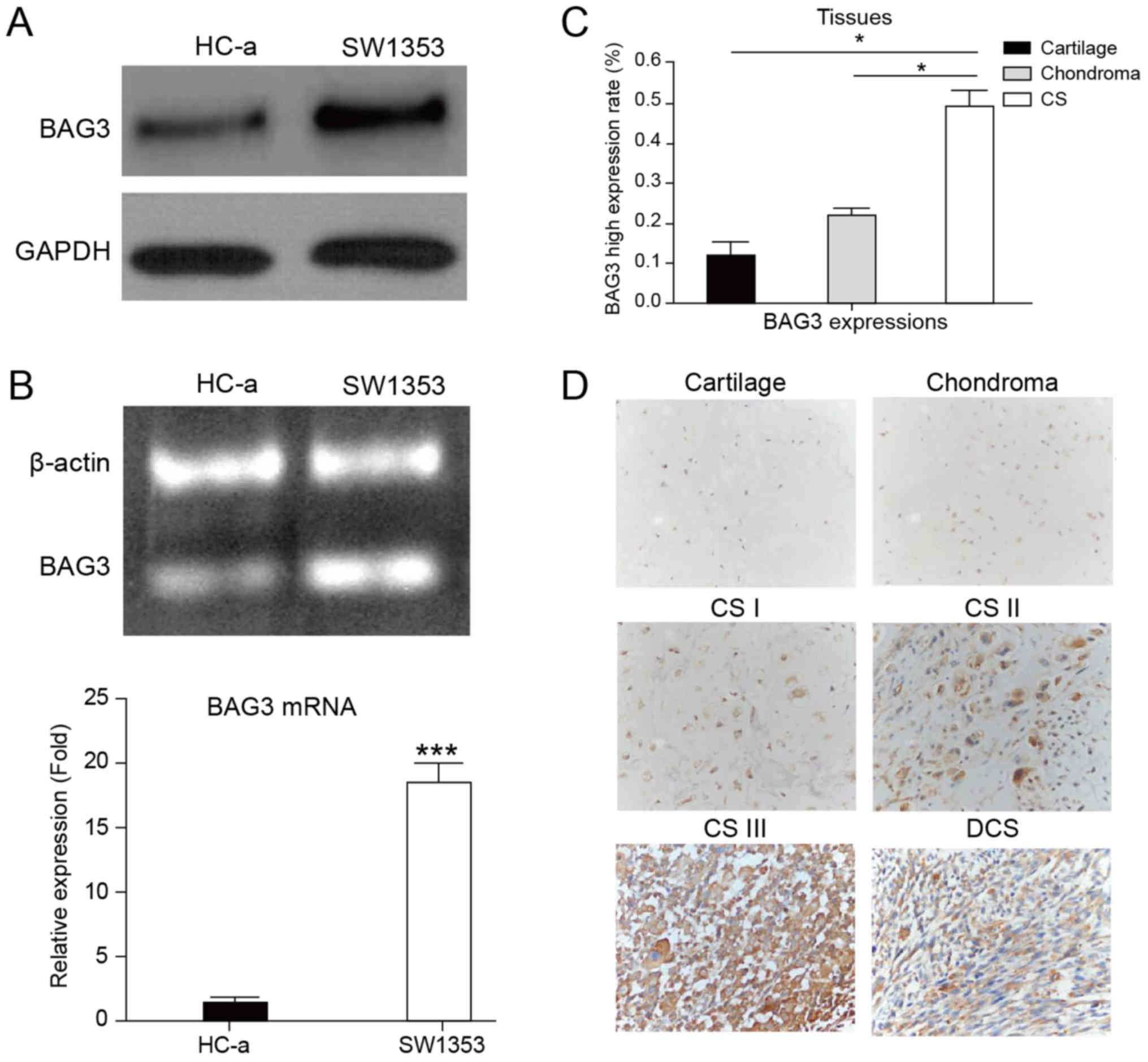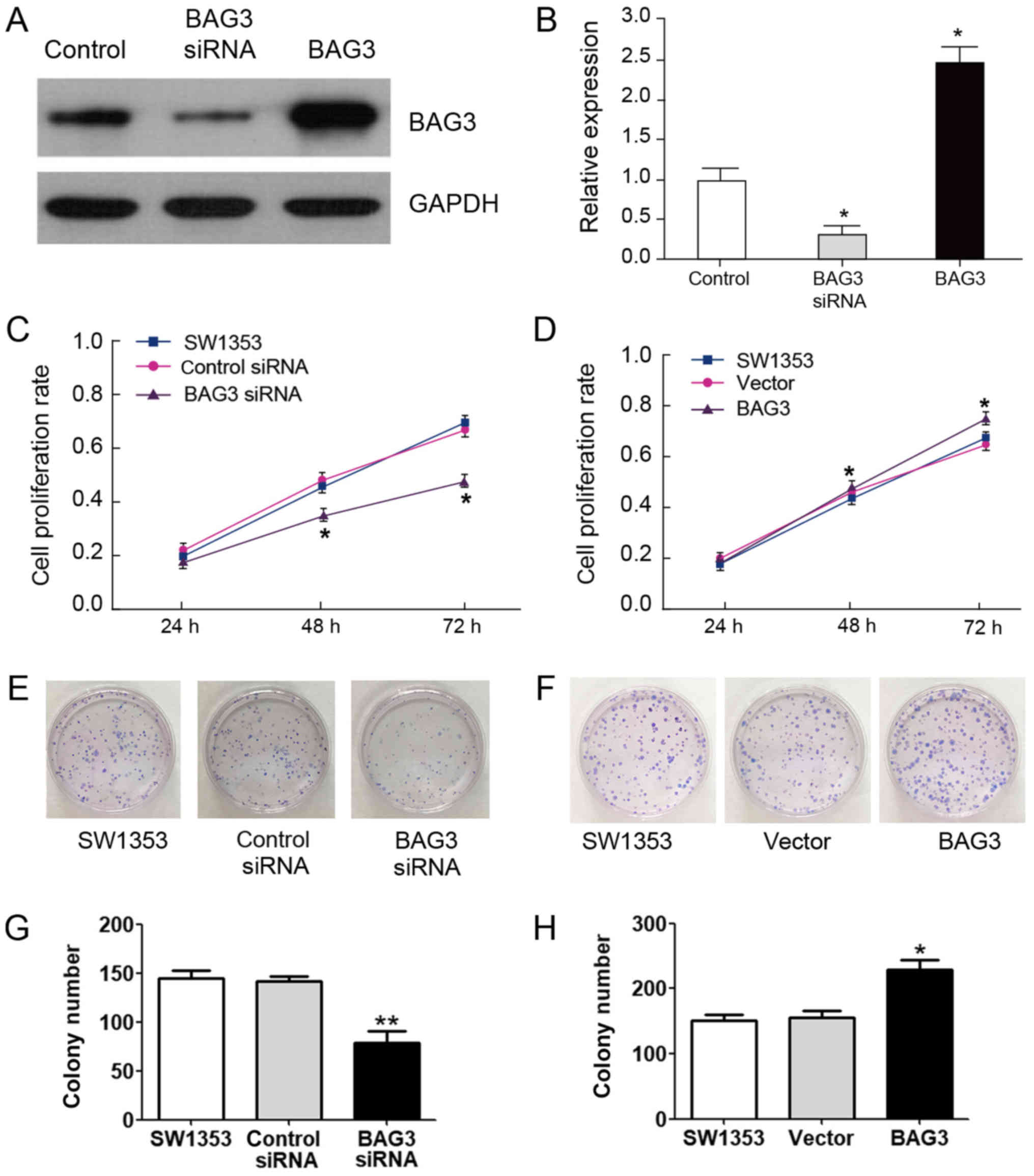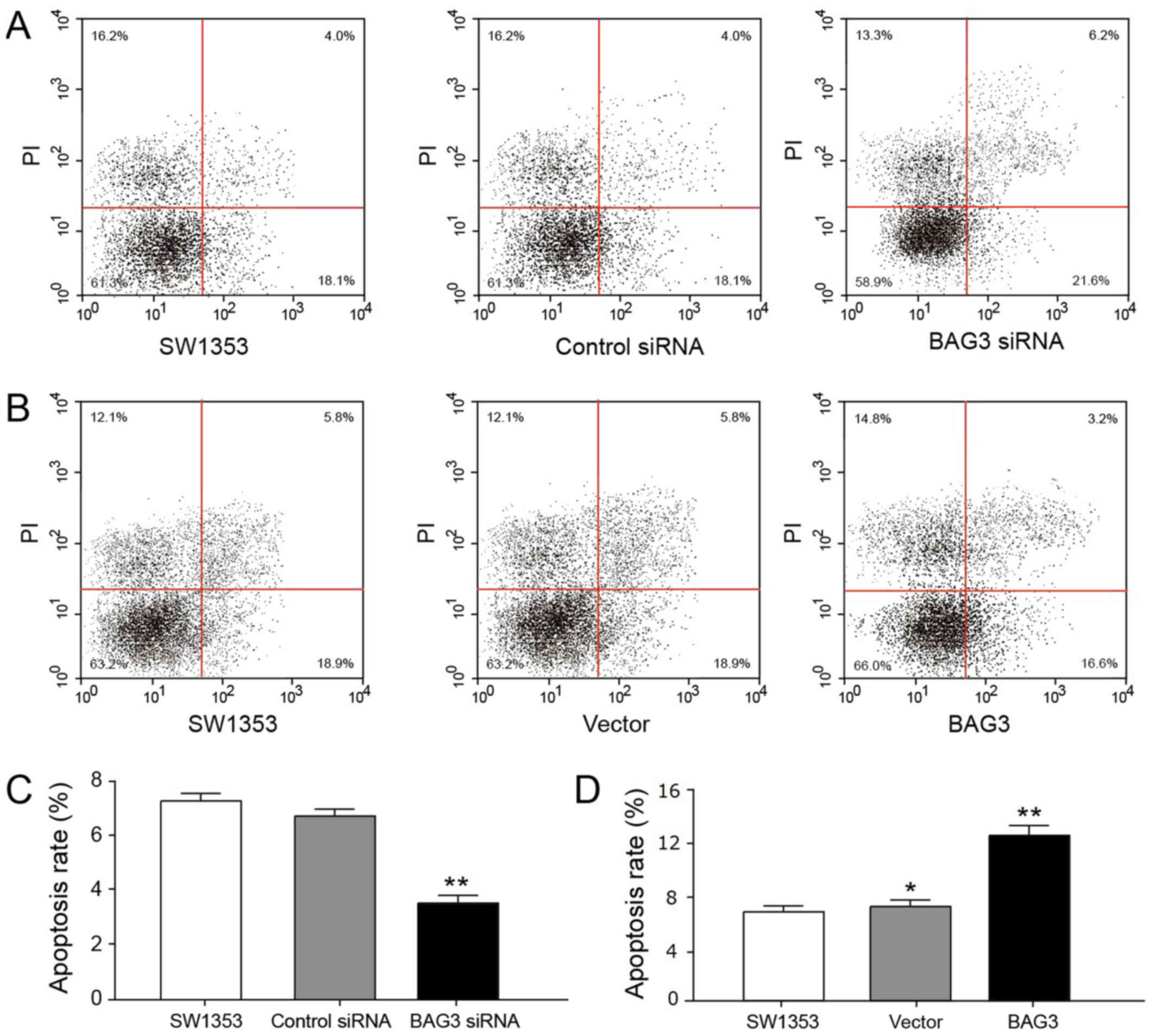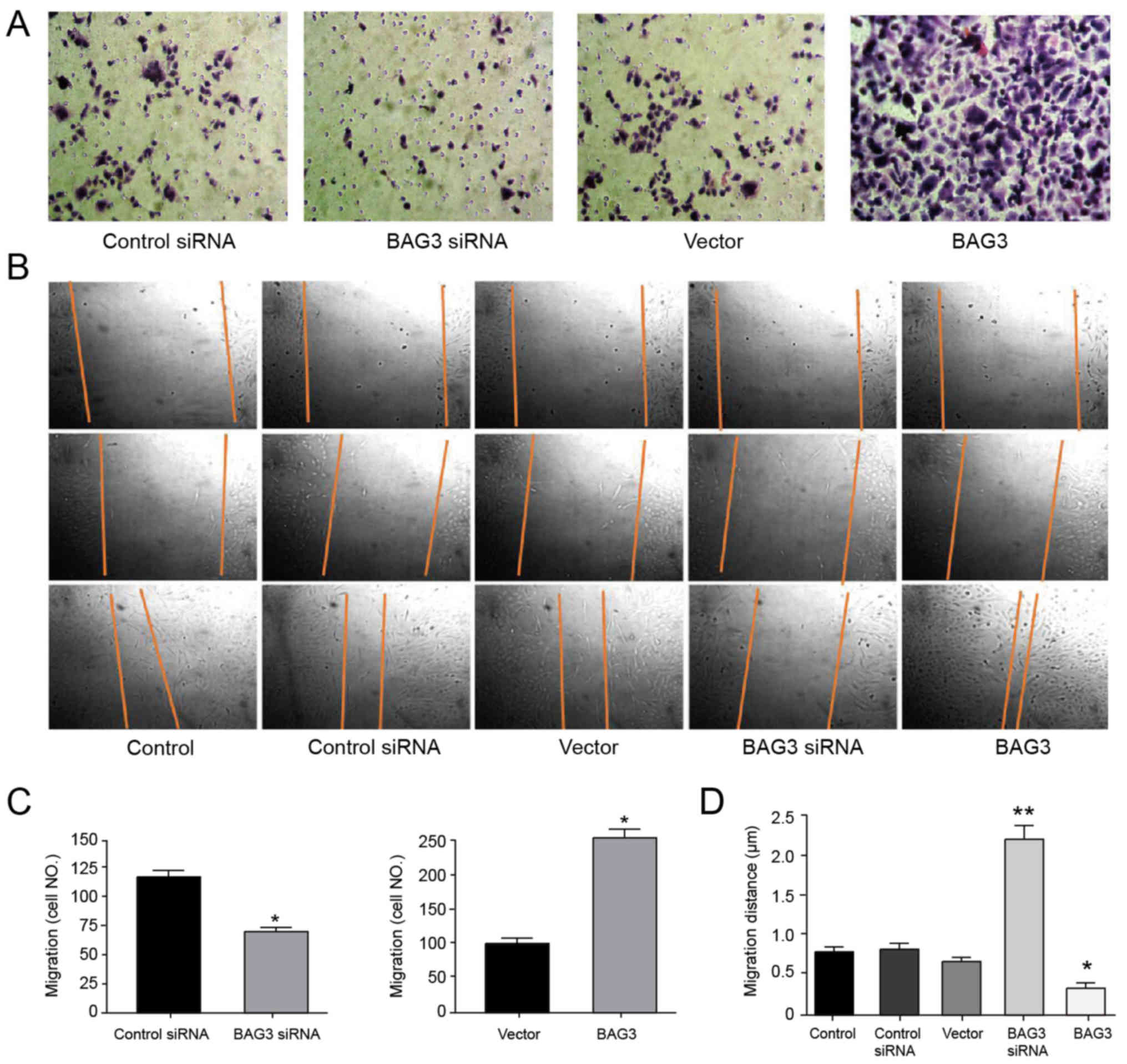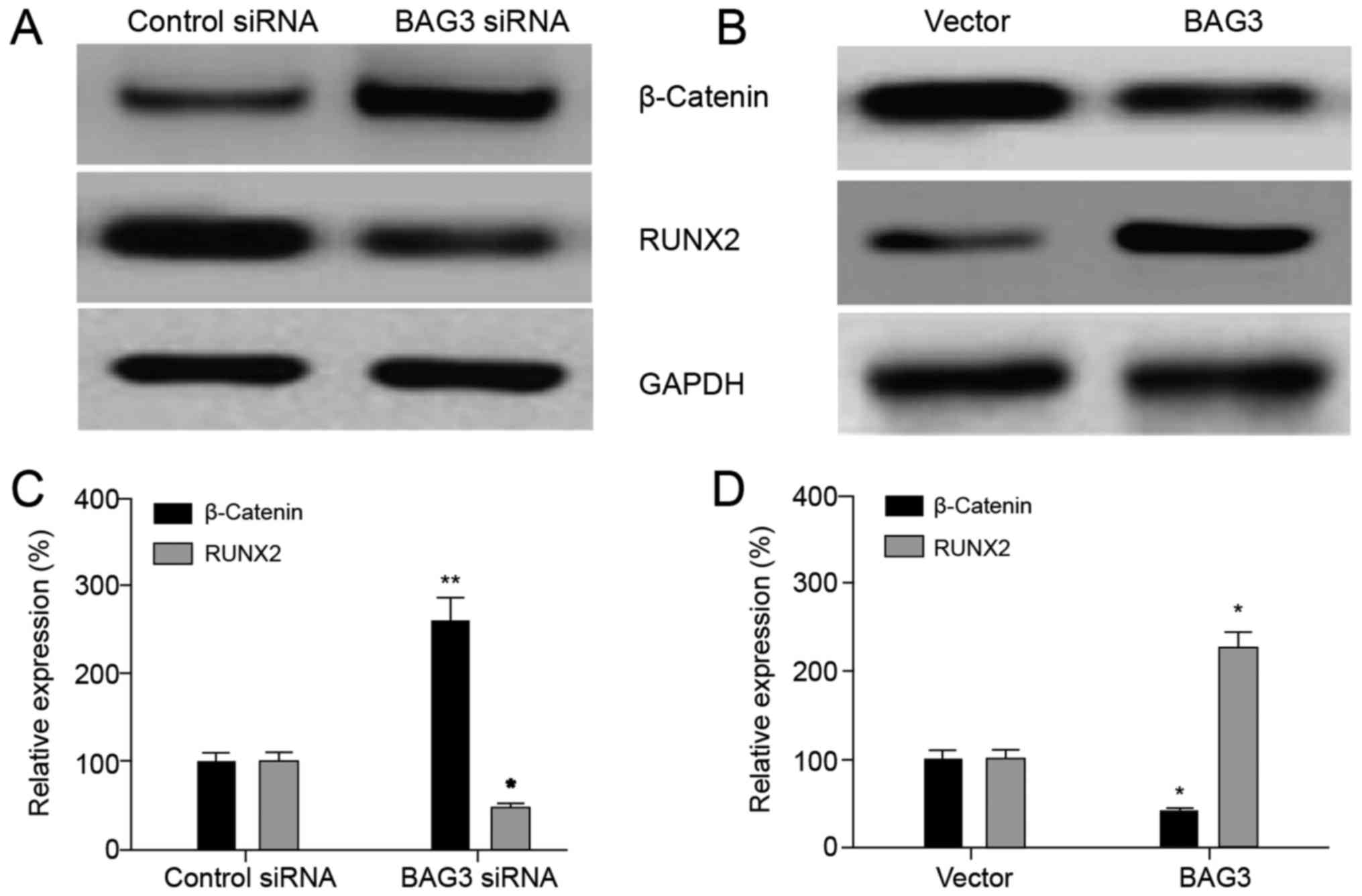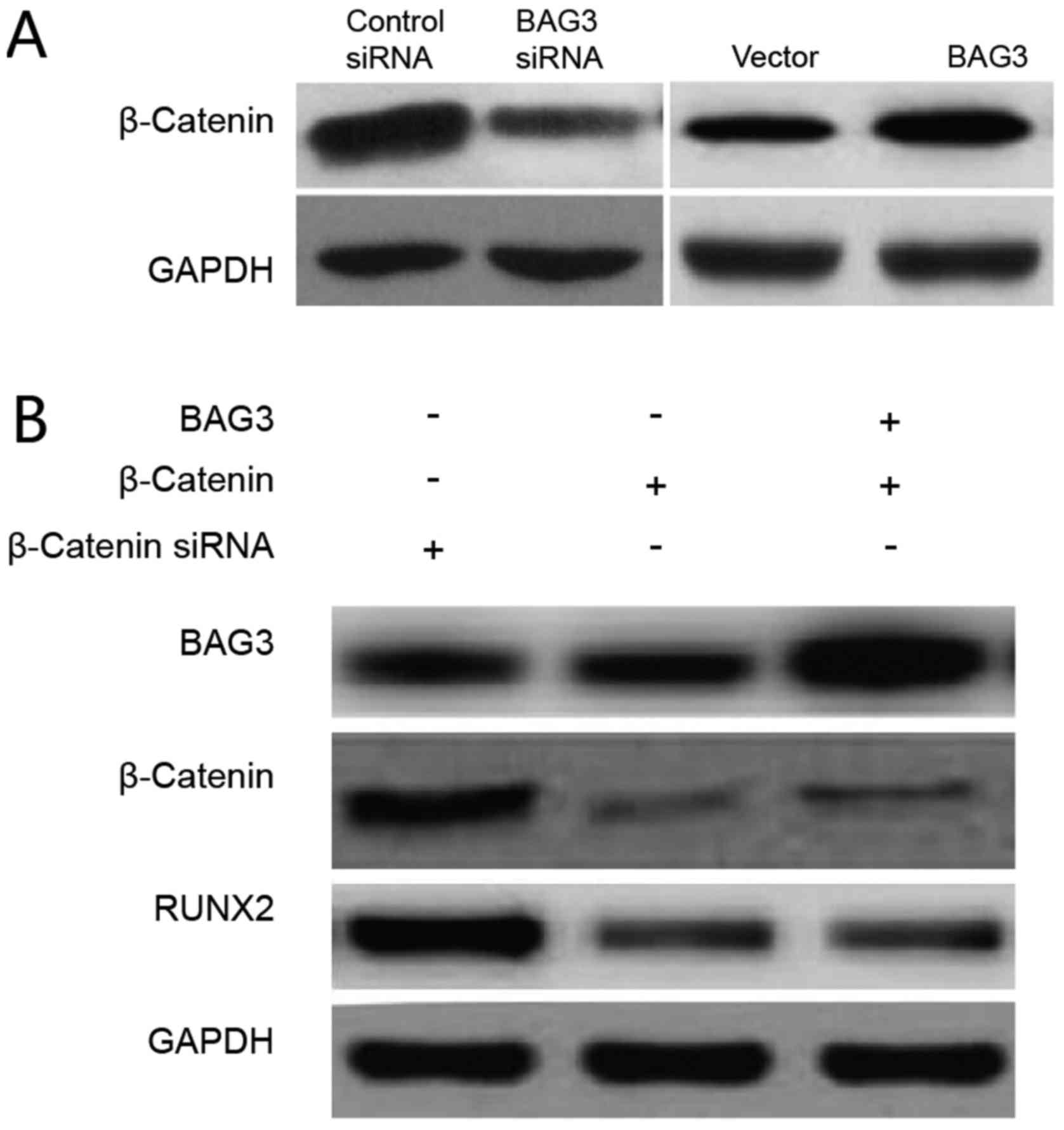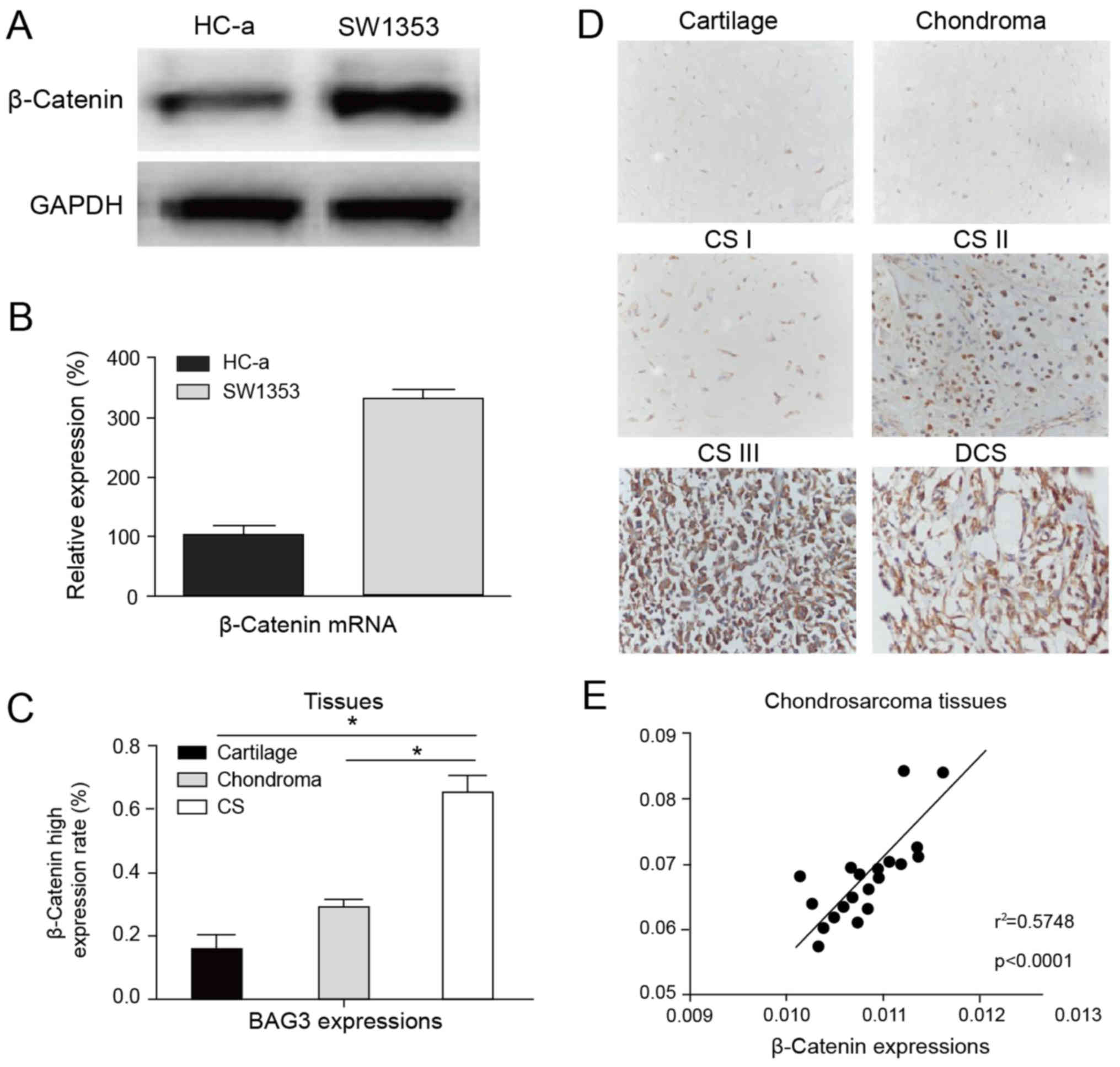BAG3 promotes chondrosarcoma progression by upregulating the expression of β-catenin
- Authors:
- Published online on: February 15, 2018 https://doi.org/10.3892/mmr.2018.8611
- Pages: 5754-5763
-
Copyright: © Shi et al. This is an open access article distributed under the terms of Creative Commons Attribution License.
Abstract
Introduction
Chondrosarcoma is a malignant cartilage-forming cancer, which is the most common primary malignant bone tumor in adults (1,2). Currently, wide local excision is the most effective treatment since the treatment of patients with chondrosarcomas displays barely response to both chemotherapy and radiation therapy (3,4). Moreover, most chemotherapy drugs for chondrosarcoma are associated with strong toxicities for normal tissues (5). Thus, effective therapeutic approaches to improve chondrosarcoma clinical outcome are still under investigation.
B-cell lymphoma-2 associated athanogene 3 (BAG3) is a member of BAG family of co-chaperones (6). It has a modular structure that contains a BAG domain, a WW domain, a proline-rich (PxxP) domain interacting with proteins (7). In addition, the WW domains connect BAG3 to SH3 domains of its binding proteins (7). The functions of BAG3 in cancers have been described. BAG3 protein is known to interact with the ATPase domain of the heat shock protein (Hsp)70 through BAG domain (8,9). A study reported that the Hsp70-BAG3 interactions regulate multiple cancer-related signaling networks (9). It has illustrated that BAG3 interacts with the SH3 domain of Src, thereby mediating the effects of Hsp70 on Src signaling (9). BAG3 has been reported to associate with GRP78, resulting in sensitization of cancer cells to DNA damaging agents (10). Moreover, it has been demonstrated that inhibition of endogenous BAG3 by siRNA could enhance the effectiveness of chemotherapy (11), suggesting that BAG3 has the potential to be a therapeutic target of human malignancies. However, the roles of BAG3 in chondrosarcoma remain unclear.
The potential roles and mechanisms of the BAG3 in modulation of chondrosarcoma malignancies have been largely unknown previously. In this study, we investigated the functions of BAG3 in human chondrosarcoma by comparison of the expressions of BAG3 in normal cartilage tissue, benign chondroma and chondrosarcoma. Meanwhile, we assessed the roles of BAG3 in the proliferation and migration of chondrosarcoma cells. Our study identified the potential roles of BAG3 in chondrosarcoma, which will contribute to the development of novel therapeutics for the treatments of chondrosarcoma patients.
Materials and methods
Patient specimens and information
Fifty-nine cases of chondrosarcoma, thirty cases of naturally express cartilage tumors and eight cases of normal cartilage tissues were randomly obtained from the Department of Pathology at the First Affiliated Hospital of Sun Yat-Sen University (Guangzhou, China) between January 2006 and November 2015. The chondrosarcoma tissues were from 33 males and 26 females. There are thirty-two cases under the age of forty-three years and twenty-seven cases over the age of forty-three years. Moreover, according to the Enneking surgical staging for musculoskeletal neoplasms classification, there are 30 cases belong to stage I, 25 cases belong to stage II and four cases belong to stage III. According to WHO histology grading: There were 31 cases in grade I, 22 cases in grade II~III and 6 cases of undifferentiated. Patients with preoperative radiotherapy or chemotherapy were excluded. In addition, normal cartilage tissues were obtained at 2–5 cm away from the tumors. The material had been fixed in 4% buffered formalin and embedded in paraffin. Prior to the research, patient's written informed consent and approval from the Institute Research Ethics Committee of The First Affiliated Hospital of Sun Yat-Sen University was obtained, and the Ethics Committee approval number is 201301.
Cell culture
The human chondrosarcoma cell line SW1353 was purchased from the Type Culture Collection of the Chinese Academy of Sciences (Shanghai, China). The normal chondrocyte cell line HC-a was purchased from Shanghai Yu Bo Biological Technology Co., Ltd. (Shanghai, China). SW1353 cells were cultivated in Dulbecco's modified Eagle's medium (DMEM) supplemented with 10% heat-inactivated fetal bovine serum (FBS). HC-a cells were cultured in RPMI-1640 supplemented with 10% FBS. All cultures contained 1% penicillin/streptomycin and were incubated in an incubator with 5% CO2 at 37°C.
Antibodies and reagents
The antibodies were purchased from: Rabbit polyclonal Anti-BAG3 antibody (cat. no. ab47124; Abcam, Cambridge, UK); rabbit polyclonal anti-RUNX2 antibody (cat. no. ab28931; Abcam); Rabbit monoclonal Anti-GAPDH antibody (cat. no. 2118; Cell Signaling Technology, Inc., Danvers, MA, USA) and β-catenin were purchased form the epithelial-mesenchymal transition (EMT) Antibody Sampler kit (cat. no. 9782; Cell Signaling Technology, Inc.).
Plasmid DNA and siRNA transfections
Expression vector containing wild type BAG3 were constructed from pcDNA3.1 according to the previous report (10). The vector was double digested at XhoI and BamHI sites. SiRNA oligonucleotides for BAG3 was purchased from Invitrogen with a scrambled siRNA as a control. The siBAG3 sequences were described as following: sense: 5′-AAGGUUCAGACCAUCUUGGAA-3′; antisense: 5′-TTCCGTGGTCTGCCTT-3′. Cells were transfected using the Lipofectamine® 2000 Transfection reagent (Invitrogen) according to the manufacturer's protocol. siRNA transfection was performed with 100 nmol/l and plasmid DNA was transfected with 2 µg. At 48 h after transfection, whole-cell lysates were prepared for further analysis.
Polymerase chain reaction (PCR) and reverse transcription-quantitative PCR (RT-qPCR)
Total RNA was extracted after homogenization of cells and tissues using RNeasy mini kit (Qiagen Sciences, Inc., Germantown, MD, USA). Total RNA (1 µg) was reversely transcribed with the High Capacity cDNA Reverse Transcription kit (Applied Biosystems; Thermo Fisher Scientific, Inc., Waltham, MA, USA). The cDNA reaction was diluted to 1:10 for use as template for RT-qPCR. TaqMan Gene Expression Assays primers and probes specific to BAG3 or β-catenin were used for expression analysis and 18S ribosomal primers and probes (Applied Biosystems; Thermo Fisher Scientific, Inc.) were used as internal controls. PCR amplifications were performed in a final reaction volume of 10 µl containing, 5.5 µl of TaqMan Universal PCR Master Mix (Applied Biosystems; Thermo Fisher Scientific, Inc.), 0.5 µl of the primers and probes mix and 4.5 µg of the cDNA diluted solution. The primers for qPCR are: BAG3-forward: 5′-TGGGAGATCAAGATCGACCC-3′; BAG3-reverse: 5′-GGGCCATTGGCAGAGGATG-3′. All qPCR reactions were carried out in triplicate and repeated at least twice. The ΔCq for mRNA expression was calculated relative to the Cq (quantitation cycle) of 18S ribosomal RNA. Relative mRNA expression was calculated using the formula 2−ΔΔCq.
Cell growth assay
For the measurements of cell growth, a total of 2.5×103 cells/well were seeded in 24-well plates. Cells were transfected with either control siRNA, siBAG3 or overexpression vector of BAG3 for 48 h. Cell growth was determined by the 3-(4,5 dimethylthiazol-2-yl)-2,5-diphenyltetrazolium bromide (MTT) assay according to the previous report (10). Absorbance was measured spectrophotometrically at 490 nm by using the Universal Microplate Reader EL800 (BioTek Instruments, Inc., Winooski, VT, USA). All experiments were performed in triplicate.
Apoptosis assay
Cell apoptosis assay was performed using Apoptosis kit with Annexin V FITC and PI from Invitrogen (Thermo Fisher Scientific, Inc.) according to the manufacturer's instructions. Briefly, cells were transfected with either control siRNA, siBAG3 or overexpression vector of BAG3 for 48 h, cells were trypsinized and 1–5×106 cells of each group were collected for the apoptosis assay. After staining with Annexin V-FITC and PI, samples were analyzed by using fluorescence-activated cell scanner (FACScan) flow cytometer (BD Biosciences, Franklin Lakes, NJ, USA).
Clonogenic assay
SW1353 cells were transfected with either control siRNA, siBAG3 or overexpression vector of BAG3 for 48 h, 1×103 cells were seeded on 10 cm dish with regular cell culture medium for two weeks and the colonies were stained with gentian violet after methanol fixation, and visible colonies (>50 cells) were counted. Colonies from randomly-selected image areas of three replicate wells were enumerated.
Cell migration assay
The cell migration assay was performed using Transwell cell culture inserts (Invitrogen; Thermo Fisher Scientific, Inc.). The cells were transfected with control siRNA, siBAG3 or overexpression vector of BAG3 for 48 h then cells were trypsinized and 5×103 cells of each group were plated to transwell insert to migrate for 24 h. The passaged cells were stained with crystal violet solution, and absorbance was measured at 595 nm. In the wound-healing assays, cell motility was assessed by measuring the movement of cells toward the scratch. The speed of wound closure was monitored after 24 h by measuring the ratio of the distance of the wound at 0 h. Each experiment was performed in triplicate.
Immunohistochemistry
For IHC, the tissue samples were cut in 4-micro meter sections. After antigen retrieval, the sections were incubated with anti-BAG3 or anti-β-catenin antibodies at 4°C overnight, followed by a HRP-labeled second antibody. The staining was photographed under an inverted light microscope (Olympus, Tokyo, Japan). The scoring criteria for staining were as follows: staining was scored by integrating the staining intensity of positive cells (trichotomy) and the percentage of positive cells in the tumor area (quartering). The scoring criteria for staining intensity were regarded as: 0, no staining; 1, light yellow staining; 2, yellow staining; and 3, brown staining. Areas: 0, no staining; 1, ≤10%; 2, 10–25%; 3, 25–50%; and 4, >50%. Two scores were multiplied to obtain a score of 0 to 12, setting 6 as the threshold by the log-rank test. Low expression, score <6; high expression score ≥6. β-catenin was judged by the Maruyama standard (12) and mainly expressed in the cell membrane. The expression of membrane was normal when ≥70% and decreased when <70%, respectively. The expression of membrane was decreased and abnormal when ≥10% plasma or nuclear expression. Immunohistochemical results were independently judged by three pathologists, and disagreeable immunohistochemical results were finally decided after discussion.
Western blotting
Cells were lysed with RIPA buffer (Thermo Fisher Scientific, Inc.). The concentration of samples was measured using the BCA kit (Pierce; Thermo Fisher Scientific, Inc.) as instructed. The lysates were separated by 10% SDS-PAGE gels, and polyvinylidenefluoride (PVDF) membranes (EMD Millipore, Billerica, MA, USA) were used for protein transfer. The PVDF membranes were then blocked by 5% skim milk containing 0.1% Tween-20 at room temperature for 1 h, and then incubated over night at 4°C with primary antibody (1:1,000). After washing with PBST the following day, the membranes were incubated with secondary antibodies (1:5,000; Invitrogen; Thermo Fisher Scientific, Inc.) at room temperature for 1 h. Then, bands were captured using BeyoECL Plus (Beyotime Institute of Biotechnology, Haimen, China) and detected using a BioImaging System. The protein expression criteria referred to previous studies (12).
Statistical analysis
Data were analyzed using the Statistical Package for the Social Sciences (SPSS), version 18 (SPSS, Inc., Chicago, IL, USA). The Pearson's Chi-square test was used to analyze the relationship between BAG3 expression and clinical pathological characteristics. One-way analysis of variance (ANOVA), Student's t-test, or Chi-square tests were used to compare differences between groups. P<0.05 was considered to indicate a statistically significant difference.
Results
BAG3 was significantly upregulated in human chondrosarcoma
Multiple studies have identified functions of BAG3 which is correlated with malignant phenotypes of cancers. To uncover the roles of BAG3 in human chondrosarcoma, we sought to compare the expression levels of BAG3 in human chondrosarcoma cell lines, SW1353 and normal chondrocyte cell line, HC-a. As we expected, BAG3 was significantly upregulated in chondrosarcoma cells at protein and mRNA levels (Fig. 1A and B). To evaluate whether BAG3 is a potential oncogene in human chondrosarcoma tissues, we measured the mRNA levels of BAG3 in normal human cartilage tissue, benign cartilaginous tumor chondroma and chondrosarcoma tissues. Consistently, the expression of BAG3 in chondrosarcoma patient tumor samples was significantly upregulated compared with normal human cartilage and chondroma tissues (Fig. 1C). In addition, we observed that the expressions of BAG3 in human chondrosarcoma were elevated according to the tumor malignant stages (Fig. 1D, Table I), indicating that the upregulated BAG3 expression might be the target for anti-chondrosarcoma therapy.
BAG3 promoted chondrosarcoma cells growth, migration and inhibited cells apoptosis. Our above results demonstrated that BAG3 might possess onco-protein functions. We next investigated the role of BAG3 in chondrosarcoma cell proliferation and tumor growth. SW1353 cells were transfected with siRNA to knock down BAG3 or overexpression vector of BAG3 (Fig. 2A and B). MTT assays results indicated that knockdown BAG3 resulted in the inhibition of cell proliferation compared with the control siRNA-transfected cells (Fig. 2C). In contrast, overexpression of BAG3 promoted the cell proliferation rates (Fig. 2D). To further confirm the role of BAG3 in chondrosarcoma cell growth in vitro, we performed clonogenic assays. Knock down of BAG3 suppressed colony formation (Fig. 2E) and overexpression of BAG3 notably increased colony formation in fourteen days (Fig. 2F), suggesting BAG3 promoted chondrosarcoma cell proliferation. We evaluated the roles of BAG3 in cell apoptosis. Consistently, results in Fig. 3A and B revealed that BAG3 is required to prevent chondrosarcoma cells apoptosis. To investigate the effect of BAG3 on the viability of chondrosarcoma cells, we counted the cell number in colony formation experiment (Fig. 2G and H) and evaluated the apoptosis rate of chondrosarcoma cells in apoptosis experiment (Fig. 3C and D).
BAG3 promotes chondrosarcoma cells migration (Fig. 4A and B). The number of migration cells in the control siRNA and BAG3 siRNA were 12 and 73, respectively. On the contrary, the number of migration cells in the control vector and BAG3 overexpression vector were 112 and 255, respectively (Fig. 4C). The maximum migration distance of BAG3 siRNA was 2,189 µm, the distance in the control siRNA and the control vector group as well as the control group were 568, 578 and 523 µm, respectively, and the minimum distance of BAG3 overexpression vector was 300 µm (Fig. 4D).
The RUNX2 in chondrosarcoma cells were upregulated by BAG3
RUNX2 was a member of the Run-related transcription factor family and is a key factor of osteoblast differentiation (13,14). Studies found that mutations in the RUNX 2 gene were closely related to bone formation in mouse model and human body. In this study, we examined the effect of BAG3 on the expression of RUNX2 gene. It was found that the expression level of RUNX2 was significantly decreased after silencing BAG3 compared with the control group and increased after overexpressing BAG3 compared with the blank load group (Fig. 5A and B), indicating that BAG3 could upregulate the expression of RUNX2, as well as β-Catenin. The relative expression levels of β-Catenin and RUNX2 proteins also showed consistent results (Fig. 5C and D).
BAG3 promoted the expression of RUNX2 through upregulation of β-catenin
To further investigate signaling pathways that involve in the BAG3-promoted the expression of RUNX2 through upregulation of β-catenin in chondrosarcoma cells, we measured the β-catenin expression in response to BAG3 knock down or overexpression in SW1353 cells. Our results in Fig. 6A demonstrated that BAG3 upregulated both protein and mRNA levels of β-catenin, intriguing us to investigate whether BAG3 promoted the expression of RUNX2 through the upregulation of β-catenin. SW1353 cells were transfected with control vector, β-catenin siRNA or β-catenin siRNA plus BAG3 overexpressing vector. As we expected, overexpression of BAG3 could not rescue the β-catenin expression in β-catenin knocking down cells (Fig. 6B), indicating β-catenin was a downstream signal molecule of BAG3. Moreover, knock down of β-catenin significantly impeded the expression of RUNX2, which could not be rescued by overexpression of BAG3 (Fig. 6B), suggesting that BAG3promoted the expression of RUNX2 through the BAG3 downstream effector, β-catenin.
An obviously positive correlation between BAG3 expression and β-catenin in chondrosarcoma tissues
To evaluate the clinical significance of the BAG3-regulated β-catenin expression in chondrosarcoma, we first compared the expressions of β-catenin in normal chondrocyte, HC-a and chondrosarcoma cell line, SW1353. We observed a significantly upregulation of β-catenin in tumor cells (Fig. 7A and B). The expression of β-catenin were upregulated in chondrosarcoma tissues compared with normal cartilage and chondroma tissues (Fig. 7C). Moreover, the expression of β-catenin was positively correlated with the malignant stages (CS I–III and DCS) of chondrosarcoma tissues in immunohistochemistry stating (Fig. 7D), which was consistent with previous reports that β-catenin acted as an oncoprotein in human cancers (15). We next evaluated whether there is positive correlation between BAG3 and β-catenin in chondrosarcoma patient specimens. We analyzed twenty chondrosarcoma tissues, and it was observed that BAG3 was correlatively expressed with β-catenin (P<0.0001, r2=0.5748) (Fig. 7E). Meanwhile, it was found that in BAG3 low-expressed chondrosarcoma tissues, β-catenin was at lower potential to be dysregulated (40%) (Table II). Meanwhile, in BAG3 high-expressed chondrosarcoma tissues, the probability of the abnormal expression of β-catenin was much higher (75.86%) (Table II). Our statistical analysis showed that there was an obvious correlation between BAG3 and β-catenin expression in chondrosarcoma patient specimens.
Table II.Associations between B-cell lymphoma-2 associated athanogene 3 and β-catenin expression in chondrosarcoma. |
Discussion
This study was to explore the role of BAG3 in chondrosarcoma and the possible mechanisms for the development of tumorigenesis. BAG3 protein has been found to be associated with anti-apoptotic functions recently. BAG3 gene contained 588 amino acids, located in 10 q25, coded one kind of Bcl-2 related proteins, and could combine with HSP70. Recent studies have shown that BAG3 is upregulated in a variety of malignant tumor, especially adenocarcinoma such as ovarian cancer (16), colon cancer (17), prostate cancer (18), pancreatic cancer (19), breast cancer (20) and thyroid carcinoma (21). Our study revealed the oncogenic roles of BAG3 in chondrosarcoma, suggesting anti-BAG3 might contribute to development of anti-chondrosarcoma drugs. It was confirmed that the expression of BAG3 was correlated with the expression of β-catenin, and previous studies have proved that the accumulation of β-catenin promoted the physiological process of Chondrosarcoma (22). Therefore, we can guess that the targeted drugs of BAG3 was studied to reduce the distribution of BAG3 in chondrosarcoma and its expression, which may decrease the accumulation of β-catenin in order to achieve low expression level of β-catenin in chondrocytes, so as to control the occurrence of chondrosarcoma. We found that the BAG3 mRNA and protein expressions were significantly upregulated in chondrosarcoma cells compared with normal cartilage cell line HC-a. Importantly, BAG3 protein expression was upregulated in 59 cases of chondrosarcoma compared with in 30 cases of patients with endogenous chondroma and 8 cases of normal cartilage. We also analyzed BAG3 protein expression levels in chondrosarcoma regarding the patient's clinical pathological parameters, clinical stage and the survival time. Therefore, it is necessary to investigate the functions and mechanisms of BAG3 during the malignant development in chondrosarcoma. We measured the cell proliferation, the colony formation, apoptosis and migration by knocking down or overexpression of BAG3 in chondrosarcoma cells. All these results consistently demonstrated that BAG3 possesses an oncogenic function in chondrosarcoma.
It has been found that β-catenin as an adhesion factor played an important role in the development of some tumors, such as breast cancer and prostate cancer (23,24). It demonstrated that BAG3 promoted the expression of RUNX2 in chondrosarcoma and that RUNX22 was involve in the migration of multiple bone tumors. Importantly, it was observed that β-catenin was a key inducing factor of RUNX2 and was upregulated by BAG3 at both mRNA and protein levels. Knockout of β-catenin in chondrosarcoma cells could not result in high expression of RUNX2 through overexpression of BAG3, indicating that BAG3 upregulated RUNX2 expression through mediating the expression of β-catenin.
We analyzed 59 cases of chondrosarcoma, 30 cases of naturally express cartilage tumors and 8 cases of normal cartilage tissues using immunohistochemical method and semi-quantitative analysis. Among them, statistical analysis showed that there was an obvious positive correlation between BAG3 and β-catenin expression, suggesting BAG3 might be involved in the development of chondrosarcoma by regulating β-catenin clinically. In summary, our study revealed oncogenic roles of BAG3 in chondrosarcoma and provided mechanisms that the BAG3-modulated the expression of RUNX2 through upregulation of β-catenin. This study provides a new foundation for molecule-targeted therapy of human chondrosarcoma.
Acknowledgements
The authors would like to thank the Department of Pathology (The First Affiliated Hospital of Sun Yat-Sen University, Guangdong, China) for supplying the patients' data.
Funding
The present study was supported by grants from the National Natural Science Foundation of China (grant nos. 81502327 and 81502021).
Availability of data and materials
All data generated and analyzed during this study are included in this published article.
Authors' contributions
WC, YD, XL and WZ collected the data. HS conducted the experiments, and drafted the manuscript and revised it critically for important intellectual content. LW analyzed and interpreted the data.
Ethics approval and consent to participate
Patient's written informed consent and approval from the Institute Research Ethics Committee of The First Affiliated Hospital of Sun Yat-Sen University (Guangzhou, China) were obtained (Ethics Committee approval no. 201301).
Consent for publication
All patients provided written informed consent.
Competing interests
The authors declare that they have no competing interests.
References
|
Gelderblom H, Hogendoorn PC, Dijkstra SD, van Rijswijk CS, Krol AD, Taminiau AH and Bovée JV: The clinical approach towards chondrosarcoma. Oncologist. 13:320–329. 2008. View Article : Google Scholar : PubMed/NCBI | |
|
Xu J, Li D, Xie L, Tang S and Guo W: Mesenchymal chondrosarcoma of bone and soft tissue: A systematic review of 107 patients in the past 20 years. PLoS One. 10:e01222162015. View Article : Google Scholar : PubMed/NCBI | |
|
Wagner MJ, Livingston JA, Patel SR and Benjamin RS: Chemotherapy for bone sarcoma in adults. J Oncol Pract. 12:208–216. 2016. View Article : Google Scholar : PubMed/NCBI | |
|
Onishi AC, Hincker AM and Lee FY: Surmounting chemotherapy and radioresistance in chondrosarcoma: Molecular mechanisms and therapeutic targets. Sarcoma. 2011:3815642011. View Article : Google Scholar : PubMed/NCBI | |
|
Italiano A, Mir O, Cioffi A, Palmerini E, Piperno-Neumann S, Perrin C, Chaigneau L, Penel N, Duffaud F, Kurtz JE, et al: Advanced chondrosarcomas: Role of chemotherapy and survival. Ann Oncol. 24:2916–2922. 2013. View Article : Google Scholar : PubMed/NCBI | |
|
Rosati A, Graziano V, De Laurenzi V, Pascale M and Turco MC: BAG3: A multifaceted protein that regulates major cell pathways. Cell Death Dis. 2:e1412011. View Article : Google Scholar : PubMed/NCBI | |
|
Fuchs M, Poirier DJ, Seguin SJ, Lambert H, Carra S, Charette SJ and Landry J: Identification of the key structural motifs involved in HspB8/HspB6-Bag3 interaction. Biochem J. 425:245–255. 2009. View Article : Google Scholar : PubMed/NCBI | |
|
Li X, Colvin T, Rauch JN, Acosta-Alvear D, Kampmann M, Dunyak B, Hann B, Aftab BT, Murnane M, Cho M, et al: Validation of the Hsp70-Bag3 protein-protein interaction as a potential therapeutic target in cancer. Mol Cancer Ther. 14:642–648. 2015. View Article : Google Scholar : PubMed/NCBI | |
|
Colvin TA, Gabai VL, Gong J, Calderwood SK, Li H, Gummuluru S, Matchuk ON, Smirnova SG, Orlova NV, Zamulaeva IA, et al: Hsp70-Bag3 interactions regulate cancer-related signaling networks. Cancer Res. 74:4731–4740. 2014. View Article : Google Scholar : PubMed/NCBI | |
|
Kong DH, Zhang Q, Meng X, Zong ZH, Li C, Liu BQ, Guan Y and Wang HQ: BAG3 sensitizes cancer cells exposed to DNA damaging agents via direct interaction with GRP78. Biochim Biophys Acta. 1833:3245–3253. 2013. View Article : Google Scholar : PubMed/NCBI | |
|
Habata S, Iwasaki M, Sugio A, Suzuki M, Tamate M, Satohisa S, Tanaka R and Saito T: BAG3-mediated Mcl-1 stabilization contributes to drug resistance via interaction with USP9X in ovarian cancer. Int J Oncol. 49:402–410. 2016. View Article : Google Scholar : PubMed/NCBI | |
|
Maruyama K, Ochiai A, Akimoto S, Nakamura S, Baba S, Moriya Y and Hirohashi S: Cytoplasmic beta-catenin accumulation as a predictor of hematogenous metastasis in human colorectal cancer. Oncology. 59:302–309. 2000. View Article : Google Scholar : PubMed/NCBI | |
|
Komori T: Regulation of skeletal development by the Runx family of transcription factors. J Cell Biochem. 95:445–453. 2005. View Article : Google Scholar : PubMed/NCBI | |
|
Banerjee C, McCabe LR, Choi JY, Hiebert SW, Stein JL, Stein GS and Lian JB: Runt homology domain proteins in osteoblast differentiation: AML3/CBFA1 is a major component of a bone-specific complex. J Cell Biochem. 66:1–8. 1997. View Article : Google Scholar : PubMed/NCBI | |
|
Lemieux E, Cagnol S, Beaudry K, Carrier J and Rivard N: Oncogenic KRAS signalling promotes the Wnt/β-catenin pathway through LRP6 in colorectal cancer. Oncogene. 34:4914–4927. 2015. View Article : Google Scholar : PubMed/NCBI | |
|
Suzuki M, Iwasaki M, Sugio A, Hishiya A, Tanaka R, Endo T, Takayama S and Saito T: BAG3 (BCL2-associated athanogene 3) interacts with MMP-2 to positively regulate invasion by ovarian carcinoma cells. Cancer Lett. 303:65–71. 2011. View Article : Google Scholar : PubMed/NCBI | |
|
Shi H, Xu H, Li Z, Zhen Y, Wang B, Huo S, Xiao R and Xu Z: BAG3 regulates cell proliferation, migration and invasion in human colorectal cancer. Tumour Biol. 37:5591–5597. 2016. View Article : Google Scholar : PubMed/NCBI | |
|
Staibano S, Mascolo M, Di Benedetto M, Vecchione ML, Ilardi G, Di Lorenzo G, Autorino R, Salerno V, Morena A, Rocco A, et al: BAG3 protein delocalisation in prostate carcinoma. Tumour Biol. 31:461–469. 2010. View Article : Google Scholar : PubMed/NCBI | |
|
Falco A, Rosati A, Festa M, Basile A, De Marco M, d'Avenia M, Pascale M, Dal Piaz F, Tavano F, Di Mola FF, et al: BAG3 is a novel serum biomarker for pancreatic adenocarcinomas. Am J Gastroenterol. 108:1178–1180. 2013. View Article : Google Scholar : PubMed/NCBI | |
|
Felzen V, Hiebel C, Koziollek-Drechsler I, Reißig S, Wolfrum U, Kögel D, Brandts C, Behl C and Morawe T: Estrogen receptor α regulates non-canonical autophagy that provides stress resistance to neuroblastoma and breast cancer cells and involves BAG3 function. Cell Death Dis. 6:e18122015. View Article : Google Scholar : PubMed/NCBI | |
|
Chiappetta G, Ammirante M, Basile A, Rosati A, Festa M, Monaco M, Vuttariello E, Pasquinelli R, Arra C, Zerilli M, et al: The antiapoptotic protein BAG3 is expressed in thyroid carcinomas and modulates apoptosis mediated by tumor necrosis factor-related apoptosis-inducing ligand. J Clin Endocrinol Metab. 92:1159–1163. 2007. View Article : Google Scholar : PubMed/NCBI | |
|
Chen C, Zhou H, Zhang X, Ma X, Liu Z and Liu X: Elevated levels of Dickkopf-1 are associated with beta-catenin accumulation and poor prognosis in patients with chondrosarcoma. PLoS One. 9:e1054142014. View Article : Google Scholar : PubMed/NCBI | |
|
Nowicki A, Sporny S and Duda-Szymanska J: β-catenin as a prognostic factor for prostate cancer (PCa). Central European J Urol. 65:119–123. 2012. View Article : Google Scholar | |
|
Calaf GM, Alvarado ME and Hei TK: Beta catenin is associated with breast cancer progression in vitro. Int J Oncol. 26:913–921. 2005.PubMed/NCBI |



